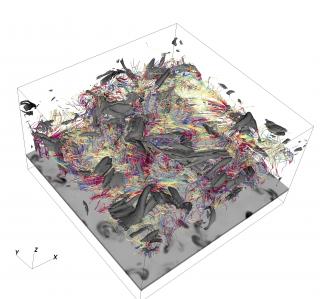Related grants:
General
The search for life in the universe has been driven by recent discoveries of planets around other stars (known as exoplanets), becoming one of the most active fields in modern astrophysics. The growing number of new exoplanets discovered in recent years and the recent advance on the study of their atmospheres are not only providing new valuable information about its physical properties, but also allowing to constrain the properties of the Solar system's planets within a more global context. The field is approaching to the important discovery of the first potentially habitable planets and encouraging more detailed studies of them. With the launching of upcoming related satellites like JWST, CHEOPS, TESS, ARIEL and PLATO, the exoplanets field faces a bright future.
It is for this reason that this field is aid of, and at the same time promotes, the development of increasingly sensitive and stable instrumentation for both, ground-based telescopes and space missions. Our group is particularly prepared for these two fronts. On the one hand, during the last years we have developed observational and reduction techniques of exoplanet transits data for the ORM telescopes, ours being one of the most productive groups in the exploitation of GTC. On the other hand, all ESA space missions (present and future) related to exoplanets have one or more components of the project as CoIs. Within the frame of this project, we intend that IAC researchers maintain an advantageous position regarding the operation of OSIRIS and CanariCam, first light
GTC's instruments, and participate in the construction, commissioning and operation of new instruments such as the high resolution optical spectrograph HORUS at GTC. The exploitation of the photometry and spectroscopy of transits with LIRIS at WHT is also one of our principal interests, especially in preparation for the installation in 2015 of EMIR on the GTC .
To summarize, the project "Exoplanets and Astrobiology" will focus on these four action lines:
1) The characterization of atmospheric and physical properties of exoplanets (GTC, WHT, ARIEL, HARPSN, CARMENES, ESPRESSO, etc. ..)
2) The search and confirmation of exoplanets by transits techniques (CoRoT, Kepler, K2, CHEOPS, XO, LCOGT, W FC, DISH, etc. ..)
3) The search and confirmation of exoplanet by radial velocity techniques (HARPSN, HORUS, LCOGT, SONG, CARMENES)
4) Astrobiology
Members
Results
- Detection of He in the atmosphere of an exoplanet from the ground, published in Science
- Detection of a super-earth around Barnard star, published in Nature
- Detection of the first TESS planets, with several papers of high relevance
- Discovery of Na and Halpha features in the spectrum of KELT-20b with TNG
- Publication of the Handbook of Exoplanets, the most extensive work of reference in the field of exoplanets. The Handbook was edited by members of our group, and includes contributions by about 300 experts worldwide, including 12 members of IAC.



![Teacup in [O III] and CO(2-1) Supermassive black holes modify the distribution of molecular gas in the central regions of galaxies. Credit: HST and C. Ramos Almeida.](/sites/default/files/styles/crop_square_2_2_to_320px/public/images/project/teacup_english.001.jpeg?itok=dF4bDw-q)